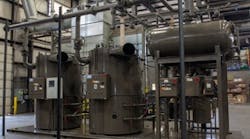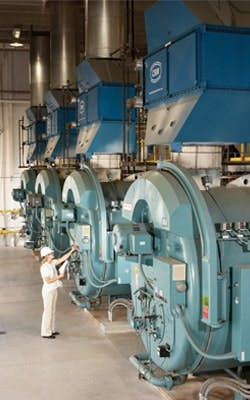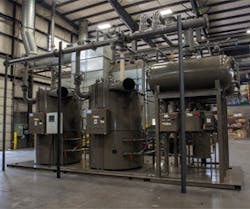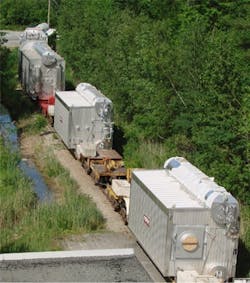In brief:
- Steam quality plays a significant role in boiler performance and efficiency, production reliability, and the longevity of the machinery itself.
- The criticality of steam quality varies by application.
- The greatest threats to industrial steam quality are maintenance and lack of knowledge of how the system is supposed to be running correctly.
Industrial and utility boiler systems alike are under increasing scrutiny for steam quality. Steam quality plays a significant role in boiler performance and efficiency, production reliability, and the longevity of the machinery itself. Steam system improvements can save 10% or more in fuel costs at a typical industrial facility, according to the U.S. Department of Energy (DOE).
“Each process needs a certain level of quality, pressure, and cleanliness of steam,” says Mike Pace, energy engineer for Horizon Energy Services (www.hs-e.com). “Steam is an effective way to transfer energy, but it requires a lot of knowledge to ensure that the system is installed correctly and running as efficiently as possible.”
Figure 1. The criticality of steam quality varies by application, but the best way to alleviate steam-quality issues is to maintain the quality of the water. (Source: Cleaver-Brooks)
Moisture in the steam can cause severe damage to the piping, valves, and other control devices, explains Nand Bogman, vice president of applications for Clayton Industries (www.claytonindustries.com). “The drier the steam, the more energy is contained in the steam delivered to the process,” says Bogman.
Although steam quality standards vary by application, common challenges are faced and the steps to achieving sufficient quality are shared:
- measure steam usage and costs
- manage the root issue (water quality)
- optimize the boiler system design
- employ maintenance best practices.
Understand the application
The criticality of steam quality varies by application. “It depends on where the steam is used,” says M. Vasudevan, vice president of operations for Cleaver-Brooks (www.cleaverbrooks.com). “If it is used to drive a turbine, it’s a big concern because there’s an acceptable limit to how much silica/solids can be carried over. Once a turbine is coated with solids, it is less efficient and carries more weight. Similarly, in food applications, steam quality is a big issue. But for heating buildings, steam quality is less of a concern, and in oil sands, where steam is pumped in the ground to heat up and release oil, steam quality is not a concern at all.” (Figure 1)
Pharmaceutical companies need particularly clean steam, adds Pace. “They ensure quality through sampling and by making sure the boiler operates at the right temperature and pressure,” he says. “On the other hand, a school department can tolerate a 30-year-old boiler that has accumulated a lot of rust, but it can still increase its efficiency with the right technology.”
Recognize the challenges
Figure 2. Inherent steam quality is based on conservative design of the boiler and the piping. (Source: Fulton Companies)
The greatest threats to industrial steam quality are maintenance and lack of knowledge of how the system is supposed to be running correctly, explains Horizon’s Pace. “A big problem is the graying of the industry, where older, experienced personnel are retiring and there is not a lot of young talent to fill their shoes,” he says.
“All too often, the new boiler designer does not have the decades of industrial steam experience required for a conservatively designed product that will deliver the required performance in a variety of challenging markets,” adds Melissa Wadkinson, chief engineer for Fulton (www.fulton.com) (Figure 2).
Not only is the workforce aging, but the assets are, as well. “The most pressing risk to boiler steam quality revolves around aging equipment, especially with regard to instrumentation and control,” says Ralph Porfilio, director of technology and application engineering for ABB's Power Generation business (www.abb.com). “So much of the equipment in industrial and utility power plants, not to mention the power grid in general, has outlived its life expectancy and is in need of either repair or replacement.”
Carryover, which results from incomplete separation of steam from the steam-water mixture in a boiler, is considered one of the greatest challenges in industrial boiler steam quality by D. Neil Bradwell, principal engineer for Indeck Keystone Energy (www.indeck-keystone.com). “Many factors, both mechanical and chemical, contribute to incomplete separation,” he says. “Mechanical factors include boiler design, inadequate or leaking separating equipment, high water levels, method of firing, and load characteristics. Chemical causes are high total solids concentrations, excessive alkalinity, and the presence of oily materials and other organic contaminants.” (Figure 3)
{pb}Figure 3. The primary consideration in the selection of a boiler and its operating conditions is the amount of carryover that can be tolerated. (Source: Indeck Power Equipment)
Boiler water carryover not only compromises steam quality, but it is also one of the biggest threats to steam system safety, explains Andy Butcher, product manager for Spirax Sarco (www.spiraxsarco.com/us). “Water carryover is droplets of water sucked up with the steam into the boiler outlet pipe,” he says. “These droplets of water not only reduce the dryness of the steam, reducing the heat content, but also travel at the high steam velocity, causing erosive damage to piping and equipment. When combined, they form high-velocity slugs that can destroy anything in their way, sometimes leading to fatal injury.”
Other risks to boiler steam quality include control system tuning to adapt for typical component usage and wear, and duty cycle changes due to renewable energies entering the grid, adds Porfilio.
Begin with benchmarking
Proper boiler system maintenance begins with benchmarking your steam usage. “It is important to understand the amount of steam used versus how much it costs,” says Horizon’s Pace. “Calculate the cost per pound of steam and benchmark that against others in your market segment. Then, as you perform routine maintenance of your steam traps, monitor how much steam you use, how you use it and why, and determine if there is a better way.”
Piping system
Piping systems impact the quality of the steam. “Piping systems and headers must be designed to facilitate draining of condensate so that it does not become entrained in the steam,” says Melissa Wadkinson, chief engineer for Fulton (www.fulton.com). “The most challenging systems to design are low-pressure steam systems, as the lower pressure steam can inherently contain more moisture.”
Separator/scrubberYou can improve steam quality by putting proper separation/scrubbing devices in the steam drum, says M. Vasudevan, vice president of operations for Cleaver-Brooks (www.cleaverbrooks.com). “A dry pipe is rudimentary for heating and drying applications where steam quality is not critical, and it delivers 99.0% purity,” he says. “A combination of belly pans as primary separator and labyrinth separator and secondary scrubbing device can deliver up to 99.5% steam quality. The high-purity steam applications, requiring 99.95% steam quality, is achieved with a system of belly pans and a chevron-type scrubber with mesh pads. The design must meet the application’s requirements in order to get to the desired purity.”
Carryover controlsCarryover is caused by poor or inappropriate water level control, lack of high-level alarms, erratic boiler pressure, and inadequate control of dissolved treatment solids, which causes foaming, explains Andy Butcher, product manager for Spirax Sarco (www.spirax.com).
“Whenever carryover is being caused by excessive boiler water concentrations, an increase in the boiler blowdown rate is normally the simplest and most expedient solution,” says D. Neil Bradwell, principal engineer for Indeck Keystone Energy (www.indeck-keystone.com). “If carryover is caused by feedwater impurities, adjustment or upgrading of the feedwater treatment system may provide the most economical solution. But ideally, to prevent the carryover caused by these contaminants, they must be removed from the boiler feedwater. So, the implementation of both a proactive boiler chemical program and a steam system management program are essential. Also, maintaining operating conditions at load or lower than design rating will decrease carryover.”
A back-pressure control valve or regulator can restrict flow when sudden changes in load may cause the boiler pressure to drop, creating conditions for carryover, says Butcher. “A high-level alarm will alert operators when the water level becomes too high nearing the outlet, increasing the chances for carryover,” he says.
SuperheaterThe boilers in petrochemical plants, refineries, and utility plants take saturated wet steam and run it through a superheater to raise its temperature, which improves the efficiency of the turbine. “If the quality is not high enough, then when the carried-over water evaporates out of the superheater tube, it leaves sediment causing overheating of the tubes and premature failure, which is very expensive,” says Vasudevan.
“Whenever superheated steam is required for process use or turbines, steam purity as low as 0.01-0.03 ppm (10-30 ppb) total solids may be required to prevent deposits,” adds Bradwell. “These limits apply to most industrial applications within a pressure range of 1,000-1,800 psig, to ensure uninterrupted service of superheaters and turbines.”
Pace recommends the U.S. DOE’s Steam System Assessment Tool (SSAT) software suite as a great first step in understanding how to use steam, its cost, and opportunities to improve. “It allows you to model different scenarios to make efficiency improvements and calculate the financial impact,” he says. “For example, you don’t want to add a $100,000 control before determining whether it is financially worthwhile. The DOE offers one-day and five-day SSAT training sessions.”
Spirax Sarco’s Butcher attributes the rise of measurement to the recent economic climate, which has companies searching for ways to save money and improve efficiency. “We’ve offered flow meters for measuring steam, condensate, and other fluids for many years, but modern technology, such as digital communications, PLCs, and software, allows us to bring that information together and give it to the user in a format that he needs: percentage efficiency and cost per pound of steam,” adds Butcher. “Not only does this allow the user to see the results of any improvements he has made, but it also flags maintenance issues. For instance, the failure of a condensate return pump will be seen as a drop in efficiency from the trend line.”
Address the root cause
The best way to alleviate steam quality issues is to maintain the quality of the water, says Cleaver-Brooks’ Vasudevan. “Water has some impurities, like silica, dissolved salts, and organics,” he says. “To prevent impurities from water particles from being carried over, you need to use better quality water, monitor it on a regular basis, and maintain it within the industry standards for recommended water quality based on the steam pressures used.”
The primary mechanism for impurities in steam is water droplets getting carried over with the steam from the boiler. “For scrubbing steam coming out of a boiler, there are a number of separation/mechanical scrubbing strategies to achieve 99.0% to 99.95% steam purity,” explains Vasudevan.
Boiler system design is crucial
Inherent steam quality is based on conservative design of the boiler and the piping, says Fulton’s Wadkinson. “The technology is not new, but it is often overlooked in today’s cost-driven market where newer boilers entering the market are designed and constructed to reduce manufacturing costs,” she says.
The primary consideration in the selection of a boiler and its operating conditions is the amount of carryover that can be tolerated, says Indeck’s Bradwell. “Once the right equipment is in place, then steam lines should be insulated and a proper steam line drip leg steam trap station should be established,” he says.
Maintenance best practices
Proper maintenance and controls can alleviate boiler steam quality threats. ABB’s Porfilio suggests the following five steps.
- Perform instrumentation and control equipment audits to help discover potential weak points and make recommendations for improvements.
- Leverage on-site support services to re-tune process control loops.
- Consider advanced control techniques such as model predictive control (MPC) and advanced coordinated control.
- Improve automation systems.
- Offer simulation systems to help train operations staff.
MPC applications are the most promising development in steam quality management, says Porfilio. “MPC applications are even more important for industrial plants — usually smaller boilers with larger swings, multiple units, and multiple steam load and pressure demands,” he says. “Excellent problem solving capabilities are possible with advanced controls.”
Outside expertise fills the void when internal skills are lacking. “When given the opportunity, we will review the project application, piping, controls and system, and make recommendations accordingly,” says Fulton’s Wadkinson. “This expertise in the entire system design and not just the boiler product has been gained through our many decades of experience in manufacturing factory-packaged boiler systems with all of the applicable components.”
Proper attention to boiler system steam quality provides industrial plants and utilities greater control over heat transfer efficiency and boiler performance, and it lowers their total cost of ownership.
“Steam sometimes gets a bad rap for being outdated, inefficient, and difficult to maintain, but it remains the most efficient way of transporting heat energy around a plant or building,” says Spirax Sarco’s Butcher. “Steam systems are so robust that they continue to work despite neglect and lack of maintenance. The problem is they then become costly to run and potentially dangerous in the same way an electrical system can. A correctly designed and maintained steam system is clean, safe, and extremely efficient.”




